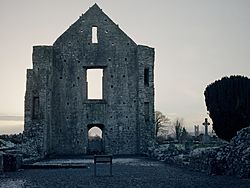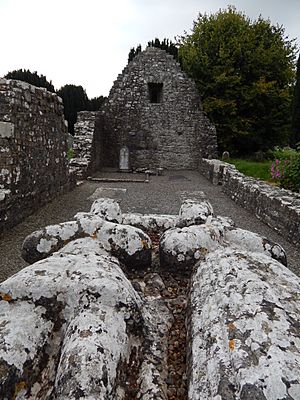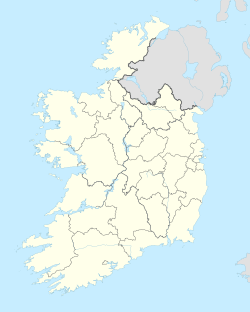Newtown Abbey facts for kids
| Mainistir an Bhaile Nua | |

West wall of the abbey church
|
|
| Monastery information | |
|---|---|
| Other names | Abbey of St Peter and St Paul |
| Order | Canons Regular |
| Established | c. 1206 |
| Disestablished | 1537 |
| Diocese | Meath |
| People | |
| Founder(s) | Simon Rochfort |
| Architecture | |
| Status | Inactive |
| Heritage designation | National Monument |
| Style | Norman |
| Site | |
| Location | Newtown, Trim, County Meath |
| Coordinates | 53°33′19″N 6°46′24″W / 53.555252°N 6.773247°W |
| Public access | yes |
Newtown Abbey is an old monastery and a National Monument in Trim, County Meath, Ireland. It's a really interesting historical site!
Where to Find It
Newtown Abbey is located about 1.2 kilometers (or ¾ mile) east of Trim town. It sits right on the north bank of the Boyne River.
A Look Back in Time
The Abbey was started around 1206 by Simon Rochfort, who was the Bishop of Meath. It was built for a group of religious people called Canons Regular, also known as "Augustinians." The Abbey was dedicated to Saint Peter and Saint Paul.
In 1216, an important meeting called a synod was held at Newtown. During this meeting, the main churches in Trim, Kells, Slane, Skryne, and Dunshaughlin were organized into smaller church districts called rural deaneries.
Later, in 1482, William Shirwood, who was also a Bishop of Meath, was buried at Newtown Abbey.
The Abbey was closed down in 1537 during a time known as the Dissolution of the Monasteries. This was when many monasteries in Ireland and England were shut down.
What It Looks Like

The main building at Newtown Abbey is the Church of St Peter and St Paul. Some people even called it a cathedral. This church has tall, narrow windows called lancet windows. To the right of the altar, you can see special seats called sedilia, which are in the Norman style. There's also a double piscina, which was used for washing the communion vessels.
There's a smaller church on the east side of the monastery. This was the local parish church for Newtown Clonbun. It's the burial place of Lucas Dillon (1530 – 1592). He was an important lawyer and judge, serving as the Attorney General for Ireland and the Chief Baron of the Irish Exchequer. His first wife, Jane Bathe, is also buried here. Their tomb effigies (statues of them on their tomb) are separated by a sword of state. Because of this, locals gave them the nickname "the jealous man and woman."


